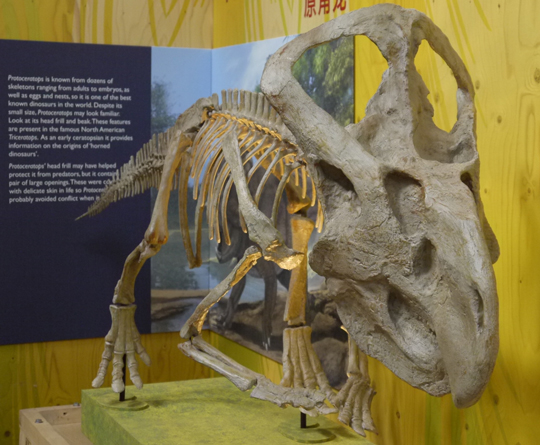Chinese Workers Build New Dam to Protect Dinosaurs
Dam to Protect Dinosaurs
Chinese construction workers have spent three years building a huge earth dam to protect priceless dinosaur bones from being washed away by the Heilongjiang river in China’s northernmost province.
Mesozoic Fossils from China
There are a number of very important Mesozoic fossil sites in China, indeed the Institute of Vertebrate Palaeontology and Paleoanthropology in Beijing has a collection of over 200,000 fossil vertebrates and this is rapidly becoming the largest collection in the world.
The Heilongjiang river, is one of the longest rivers in China and marks the border between Russia and China. The name means “Black Dragon River”, which is very appropriate considering the number of dinosaur bones that are revealed each year as flood-waters erode riverbanks.
Protoceratops Dinosaur Specimen on Display

A skeleton of a Protoceratops on display. A dam is being built to protect dinosaur fossil bones. Picture credit: Everything Dinosaur.
Picture credit: Everything Dinosaur
To view models and replicas of Chinese dinosaurs and other prehistoric creatures: PNSO Age of Dinosaurs Figures and Models.
Thousands of Dinosuar Bones
To date, thousands of dinosaur fossil bones have been unearthed from the surrounding sediments. Thirteen complete dinosaur skeletons have so far been excavated, these are on display at a number of Chinese museums. Palaeontologists have estimated that there may be as many as 100 more complete dinosaur skeletons waiting to be discovered but every summer flooding from the Heilongjiang river washes away fossil deposits. Although the waters do help to expose fossils a large number of specimens have been washed away and lost.
Protecting Dinosaurs
The Land and Resources Department of Heilongjiang Province ordered the building of a 1, 450 metre long earth embankment on the Chinese side of the river to prevent the fossils being washed away. The dam has taken three years to complete, the work has been hampered due to the cold winters and the problem with the summer flood-waters interrupting the construction work.
The fossil rich area is to be called Dinosaur Mountain and this area is now protected from the damage caused by the flood-waters. This site is part of the Jiayin Dinosaur National Geological Park and the new earthworks should help palaeontologists recover many more dinosaur specimens.

